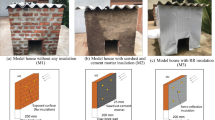Abstract
The uses of waterproofing materials for insulation including required optimal thickness are discussed in this work. There exists a difference of five orders of magnitude in the diffusion coefficient of building materials along with the four orders of magnitude in the thickness and diffusion length. The radon resistance offered by materials varies with (a) thickness for given diffusion coefficient and (b) with diffusion coefficient with same thickness to diffusion length ratio (d/L). The earlier assumption of using thickness equal to three times of diffusion length is not workable for all materials but it causes an underestimation or overestimation.




Similar content being viewed by others
References
ICRP (1993) Protection against radon-222 at home and at work. vol 23. ICRP Publication 65 Annals of the ICRP (1993)
WHO (2009) Handbook on indoor radon a public health perspective.
ICRP (2007) The 2007 Recommendations of the International Commission on Radiological Protection. ICRP Publication 103. Ann. ICRP 37 (2–4)
Vuckovic B, Gulan L, Milenkovic B, Stajic JM, Milic G (2016) Indoor radon and thoron concentrations in some towns of central and South Serbia. J Environ Manag 183:938–944
Chakraverty S, Sahoo BK, Rao TD, Karunakar P, Sapra BK (2018) Modeling uncertainties in the diffusion-advection equation for radon transport in soil using interval arithmetic. J Environ Radioact 182:165–171
Chauhan RP, Kumar A (2015) A Comparative study of indoor radon contributed by diffusive and advective transport through intact concrete. Phys Procedia 80:109-112
Jiránek M, Kotrbatá M (2011) Radon diffusion coefficients in 360 waterproof materials of different chemical composition. Radiat Prot Dosim 145(2–3):178–183
Fernández PL, Quindós LS, Sainz C, Gómez J (2004) A theoretical approach to the measurement of radon diffusion and adsorption coefficients in radon proof membranes. Nucl Instrum Methods Phys Res Sect B Beam Interactions Mater Atoms 217(1):167–176
Kumar A, Chauhan RP, Joshi M, Sahoo BK (2014) Modeling of indoor radon concentration from radon exhalation rates of building materials and validation through measurements. J Environ Radioact 127:50–55
Jiránek M, Svoboda Z (2017) A new approach to the assessment of radon barrier properties of waterproofing materials. Radiat Prot Dosim 177(1–2):116–120
Ashry AH, Abou-Leila M, Abdalla AM (2011) Measurement of radon permeability through polyethylene membrane using scintillation detector. Radiat Meas 46:149–152
Tsapalov A, Gulabyants L, Livshits M, Kovler K (2014) New method and installation for rapid determination of radon diffusion coefficient in various materials. J Environ Radioact 130:7–14
Tsapalov A, Kovler K (2016) Revisiting the concept for evaluation of radon protective properties of building insulation materials. Build Environ 95:182–188
Jiranek M, Svoboda Z (2009) Transient radon diffusion through radon-proof membranes: a new technique for more precise determination of the radon diffusion coefficient. Build Environ 44(6):1318–1327
Chauhan RP, Kumar A (2013a) Radon resistant potential of concrete manufactured using ordinary Portland cement blended with rice husk ash. Atmos Environ 81:413–420
Chauhan RP, Kumar A (2013b) Study of radon transport through concrete modified with silica fume. Radiat Meas 59:59–65
Kumar A, Chauhan RP (2017) Radon diffusion and exhalation from mortar modified with fly ash: waste utilization and benefits in construction. J Mater Cycles Waste Manag 19(1):318–325
Singh P, Sahoo BK, Bajwa BS (2016) Theoretical modeling of indoor radon concentration and its validation through measurements in South-East Haryana, India. J Environ Manag 171:35–41
Jiránek M (2017) New, efficient and generally applicable design of radon-proof insulations—a proposal for a uniform approach. Radiat Prot Dosim 177(1–2):121–124
Kumar A, Chauhan RP (2014) Active and passive measurements of radon diffusion coefficient from building construction materials. Environ Earth Sci 72(1):251–257
Czech Technical Standard C SN 73 0601 (2006) Protection of buildings against radon from the soil, UNMZ
Muñoz E, Frutos B, Olaya M, Sánchez J (2017) A finite element model development for simulation of the impact of slab thickness, joints, and membranes on indoor radon concentration. J Environ Radioact 177:280–289
Keller G, Hoffmann B (2000). The radon diffusion length as a criterion for the radon tightness. In: IRPA10 conference proceedings, Hiroshima 2000
Saâdi Z, Guillevic J (2016) Comparison of two numerical modelling approaches to a field experiment of unsaturated radon transport in a covered uranium mill tailings soil (Lavaugrasse, France). J Environ Radioact 151:361–372
ICRP (1993) Protection against radon-222 at home and at work. ICRP Publication 65 Ann. ICRP 23 (2)
Acknowledgements
The authors are thankful to Director, National Institute of Technology, Kurukshetra and Board of Research in Nuclear Science, Department of Atomic Energy (BRNS-DAE), Mumbai for providing the research facility for carrying out this work.
Author information
Authors and Affiliations
Corresponding author
Ethics declarations
Conflict of interest
There is no conflict of interest for publication of this manuscript.
Additional information
Publisher's Note
Springer Nature remains neutral with regard to jurisdictional claims in published maps and institutional affiliations.
Rights and permissions
About this article
Cite this article
Kumar, A., Chauhan, R.P. Measurement of optimal thickness of radon-resistant materials for insulation using diffusion coefficient. J Radioanal Nucl Chem 327, 425–431 (2021). https://doi.org/10.1007/s10967-020-07507-9
Received:
Accepted:
Published:
Issue Date:
DOI: https://doi.org/10.1007/s10967-020-07507-9




